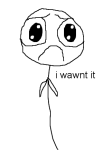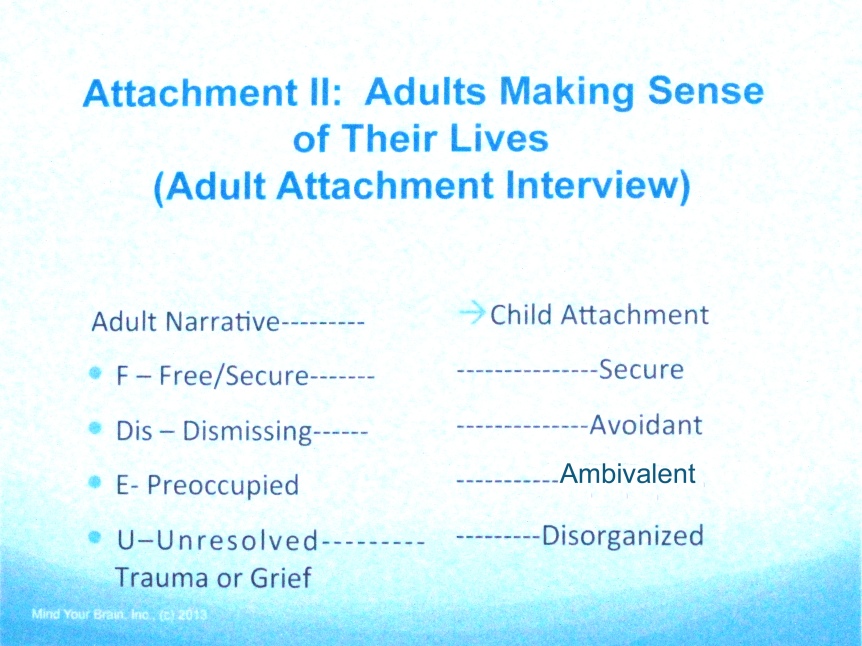THE HUMAN ATTACHMENT SYSTEM & INTERGENERATIONAL TRAUMA
[Text of Powerpoint Presentation]
- Trauma and its consequences for the following generation of children
- Known as ‘second generation’ trauma
- Second generation trauma must be understood in the context of the biological human attachment system
THE ATTACHMENT SYSTEM
- Innate, biologically determined
- An evolutionary imperative
- Necessary for the human infant to:
- Survive
- Grow (specifically, for the brain to develop)
- Established by 7 months of age
- Human infant must seek proximity to another human, hopefully a safe caregiver
- Human infant must seek alignment and attunement with a mature brain.
- Through close attunement, the infant learns:
- to manage his/her emotional arousal
- to regulate her/his behaviour
- begins the task of organizing the Self
- This is accomplished through ‘contingent’ communication, a practice familiar to therapists. (‘contingent’ explained under ‘secure attachment’)
- Through close attunement, the infant learns:
The Biological Mechanism of Attachment
- What are the mechanisms that propel human pair bonding?
- An array of neuro-hormones and neuro-transmitters are behind this behaviour.
- Those that are part of our innate survival mechanism:
- The neurotransmitter/hormone norepinephrine which creates the sensation of FEAR arising from innate ‘knowledge’ of potential danger.
- The infant brain is biologically highly attuned to danger – an evolutionary artifact.
- The only mechanism the infant brain has to modulate that innate fear of danger is through attunement and alignment with a mature brain.
- Those that reinforce the seeking of proximity
- Oxytocin (the love hormone)
- Vasopressin (involved in pair-bonding but known mainly for other processes)
- Prolactin (lactation, but affects maternal behaviour)
THE ATTACHMENT SYSTEM’S CATEGORIES
Mary Ainsworth and the ‘Strange Situation Assessment”
- Mary Ainsworth originally recognized 3 categories of infant attachment
- Secure attachment
- When reunited with the absent parent, child seeks proximity and comfort, and then soon returns to play
- Insecure Avoidant (Dismissive)
- When reunited, child appears indifferent, continues to play as if parent has not returned, “but in fact registers heart rate increase and nervous system response”.
- Insecure Ambivalent (Unresolved)
- When reunited, child seeks proximity, but is not consoled or reassured, clings, and does not return to play
- Secure attachment
- Caregivers are able to practise contingent communication,
- Ie, communication that is aligned with the child’s state of mind,
- That recognizes distress and is able to soothe it,
- That recognizes pleasure and is able to validate it
- That is consistent
- Insecure Avoidant Attachment
 Caregiver is emotionally distant,
Caregiver is emotionally distant,- Is neglectful and rejecting
- Appears unable to read child’s emotional signals, and unable to respond effectively when they do read them
- Shows language expression that is independent of facial emotion
- Seemingly unable to conceptualize the mind of the child
Adult dismissive state of mind (“memories from an emotional desert”)
 “Dismissive” parents have learnt to dismiss their own emotional needs
“Dismissive” parents have learnt to dismiss their own emotional needs- Tend to intellectualize experience
- Child gives up expectation of having their emotional needs met
- Child learns to dismiss their emotional feelings
- So categories of ‘avoidant’ and ‘dismissing’ can both be thought of as ‘dismissive’
- Insecure Ambivalent Attachment (Unresolved)
- Caregiver is inconsistently attuned with child
- Sometimes emotionally unavailable
- Sometimes emotionally intrusive
- Tends to try to meet their own emotional needs through the child
- Preoccupied with own emotional baggage
- Unable to perceive the mismatch between their’s and their child’s needs.
Adult Preoccupied state of mind (“intrusion of the past into the present”)
- Caregiver is“preoccupied” with unresolved emotional baggage
- Child’s appearance and actions trigger latent memories
- Marital situation may resemble family-of-origin’s dynamics
- Memory ‘priming’ and ‘state-dependent’ memory – contextual cues and similar mental state as original event
- The emotional turmoil is centred around attachment issues
- The Child learns that his/her emotional needs MAY be met, but just as likely may not.
- Uncertainty creates an internalized representation , a ‘virtual other’ that is filled
 with uncertainty and intrusion
with uncertainty and intrusion - This child may be unable to accurately assess others’ intentions, and will tend to both need and want attention, yet push it away.
- So categories of ‘ambivalent’ and ‘preoccupied’ can both be thought of as “unresolved and preoccupied”
- Fourth Category of Attachment arising from the Strange Situation Assessment
On return of the parent, child moves towards them then turns away, may freeze, eyes glazed over, disoriented, vacant, or rocking back and forth.
- Insecure Disorganized / Disoriented
- In other words, behaviour is disorganized and mental state is disoriented
- This category is given along with a simultaneous assignment of ‘avoidant’ or ‘ambivalent’
- This infant behaviour correlates with caregiver/s who are traumatized.
Insecure Disorganized/Disoriented Attachment (“Parental PTSD”)
- Caregiver communication is unusual
- Involves frightened, frightening and disoriented behaviours
- Disorganized behaviour evolves from incoherent life stories, intrusive traumatic memory, overwhelming anxiety states etc (ie PTSD – intrusive and hyperaroused categories)
- Disoriented behaviour evolves from abrupt shifts in states of mind, ie dissociative symptoms (PTSD – avoidance strategies)
Disorganized/Disoriented Attachment in children with traumatized parents
- Caregivers with unresolved/disorganized states of mind present the child with an unsolvable dilemma
- The child cannot make sense of the parent’s facial and other cues, because they are internally generated and bear no reference to the child’s reality
- The infant cannot organize a strategy from within their attachment mechanisms, because they cannot use the parent to become soothed or oriented
- The caregiver has become the source of the danger and fear
- The child’s internal state of mind becomes incoherent.
- Stuck between approach and avoidance, the flight or fight response is overwhelmed, and a trance-like freeze is the autonomic response of the nervous system.
Clinical Dissociation
- The ‘freeze’ of the ANS (autonomic nervous system) can be the beginning of a tendency towards clinical dissociation
- Dissociation : fragmentation of consciousness, states of mind, information processing, memory and identity.
- The above processes are normally integrated by connections and networks throughout the neural pathways of the brain
Developmental Consequences for children with disorganized/disoriented attachment
- As children, often hostile and aggressive with peers.
- Controlling interactions that impair social relationships
- Serious family dysfunction (negotiating conflict, chronic maternal depression, child abuse, parental behaviour that is controlling, helpless and/or coercive)
- In later life, found to have the most difficulty with emotional, social & cognitive impairments
- Highest likelihood of clinical problems and disorders, including dissociative disorders
“ORGANIZED” INSECURE ATTACHMENT
What is ‘Organized’ Attachment?
- Avoidant (dismissive) and Ambivalent (preoccupied) attachments are less than optimal
- BUT they are organized adaptations that allow the child to formulate some coherent sense of attachment
- Sufficient to allow the brain to develop its neural connections in an organized way
- Ie, neural connections can be integrated, allowing a ‘core self’ to emerge, with a sense of memory, personal identity, narrative past and coherent present.
- With insecure/disorganized/disoriented attachment, an organized adaptation is not achieved.
- This is because parent is the source of the fear and confusion.
- Child learns to attune their mind to the dissociative and chaotic mental state of parent
- This is expressed at the level of neuronal connections which are chaotic and dissociated.
- Operative word for this classification is Unresolved
- It is not the trauma and/or loss that infects the child
- It is that the fear and terror from the trauma, or the grief of unbearable loss are not integrated in the parent survivor’s mind.
- We have a situation of Post-traumatic Stress Disorder.
HOW ADULTS’ PERSONAL LIFE NARRATIVES PREDICT THEIR PARENTING STYLES






